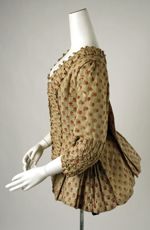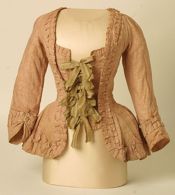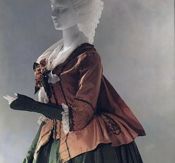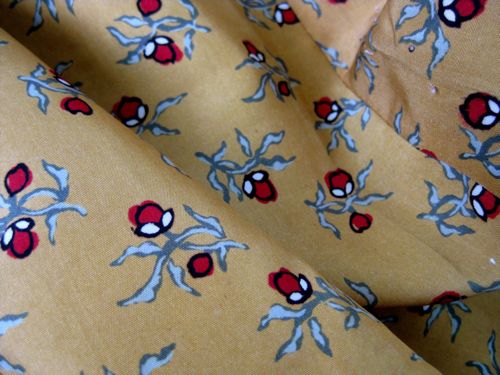The Idea and Inspiration:
I found a vintage obi made from gorgeous block-printed silk in colours and designs that perfectly matched examples of fabrics imported to Europe from India in the 18th century. That obi fabric was the impetus behind the entire project.
As it was such a small amount of fabric I was very limited in what I could make out of it, so I settled on a late 18th century pet-en-l’aire. I felt that the back pleats would be the best way to show off the fabric, but that a jacket could still be worn with a non-matching petticoat, as I didn’t have enough fabric for a matching petticoat. I based my pet off of a pet in the Metropolitan Museum of Art, and one at the Manchester City Gallery, with a bit of input from one at the Kyoto Costume Institute.
Because I am getting more and more crazy about historical accuracy I’m hand-sewing most of the jacket.
Inspiration Gallery
 |
 |
 |
| Pet-en-l’aire, 18th century, Met | Pet-en-l’aire, 1780-90, MCG | Pet-en-l’aire, 1775-80, KCI |
Fabric and Materials:
- One vintage silk habotai obi with a block printed pattern of little flowers in red, black, white and sage green on yellow
- Linen for the bodice support
- Lightweight cotton muslin lining
- German plastic boning
The Undergarments & Accessoires:
- Worn over an 18th century shift, 1770s gilded linen stays, and a 1780s bum rump.
- Worn with a 1780s striped muslin walking length petticoat and a late-18th century begere
The Dress Diary:
- Introducing the pet-en-l’aire, and beginnings
- The back pleats, and remaking
- Finishing the back pleating
- The compere front
- The pet at Premier House
- Pretty princesses in yellow photoshoot
- The pet and 18th century Orientalism photoshoot
- The pet at afternoon tea at the Coronation Cafe
- Afternoon tea two
- Thoughts on pet-trim
- Trimming the pet, and thoughts on sleeve trim
- The fully embellished pet-en-l’aire
- The petticoat and pet-en-l’aire photoshoot
Research and helpful links:
- Arnold, Janet. Patterns of Fashion: The Cut and Construction of Clothes for Men and Women, 1660-1860.
- Hart, Averil and North, Susan. 17th and 18th Century Fashion in Detail, London: V & A Publishing. 2009.
- Hunnisett, Jean. Period costume for stage & screen. Patterns for women’s dress, 1500-1800
- Waugh, Norah. The Cut of Women’s Clothes: 1600-1930. Faber and Faber: London. 1968

